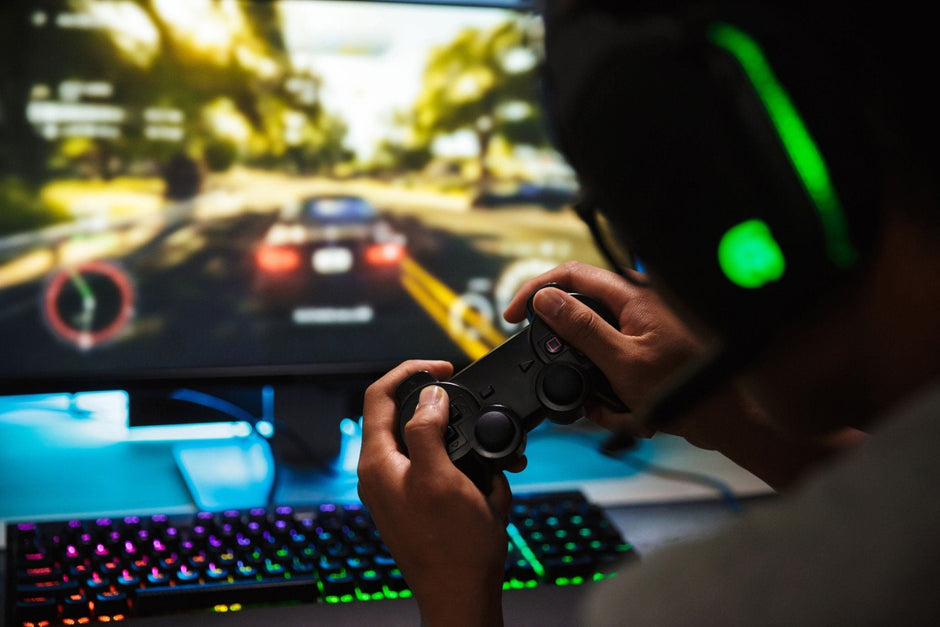Any gamer knows a single monitor is good, but dual monitors are even better. In fact, having at least two monitors on display is part of any typical gaming setup these days. Much like when used for business, dual monitors allow you to see more content and complete multiple tasks simultaneously. When learning how to set up multiple monitors for gaming, the installation and configuration are similar.
There are several factors to consider when setting up more than one monitor. Monitor placement, accessible ports, and screen resolution display settings are all important to create an optimal user experience, whether you have a dual or triple monitor setup. Once you’ve determined the area in your home where you want to set up your gaming center, map out the setup and see what adjustments may need to be made to maximize the space and keep it from looking too cluttered. How will you strategically position all of the monitors? Will you use monitor mounts or clunky pieces of furniture?
Like all the pro gamers that have come before, as you make the leap past the single monitor for your online activities, it’s tough to turn back. In the gaming industry especially, having more than one monitor is a key asset when learning how to successfully work from home.
Step #1: Choose the Right Equipment Placement
Not everyone has access to unlimited space to create a gaming setup that can accommodate super ultrawide monitors. Desks and shelves have limited space to begin with, so how to make room for two, let alone three or more monitors? Consider the advantages of computer monitor mounts. A floating desktop or wall mount creates space for other equipment or accessories that require room. For example, if you don’t have the option of taking up more surface, try moving your equipment vertically with a wall mount. With the perfect mount, we can even show you how to use a computer monitor as a tv for gaming purposes.
The different styles of external monitor mounts give you the ability to adjust per your seating arrangement. A desktop mount allows you to angle multiple monitors to sit on the same level and adjust so you don’t have to crane your neck or lean forward. An ergonomic setup is essential, especially for marathon gaming sessions. Having everything within easy reach and at eye level helps you to maintain a healthy posture and also eases the strain on your eyes. When partaking in long gaming sessions, it’s important to consider which part of your body is affected by poor ergonomics so that you can keep up your momentum and stay focused, without putting stress on your body.
Additionally, features like a swivel or adjustable arms on the mount allow you to situate the multi-monitor set up at an optimal angle to remove any glare from lighting to improve the experience.
Step #2: Assess All Required Ports
When setting up multiple monitors, you want to make sure you have enough of the correct ports to hook up two or more screens. There are four common monitor connection types. These are HDMI, VGA, DVI, and DisplayPort input. Fortunately, most modern ports already have HDMI and DisplayPort connections.
Once hooked up, it’s easy to go into your computer’s display settings to configure the orientation for how you want your standard or super ultrawide monitors set up. This may take a few tries to figure out what works best and can always be reconfigured if you want to make a switch in the future.
If you’ve already been using a single monitor mount, the Dual Monitor Mount Adapter easily turns the setup into two. You can rotate screens between portrait and landscape views and tilt to find the perfect angle. This is an affordable, easy-to-assemble option that can quickly transform your desk or shelf space into a streamlined gaming setup.
Step #3: Secure the Best Resolution Quality
Now that you’ve chosen the right placement for your gaming setup and have confirmed your primary monitor and extra monitors have the correct ports for connection, it’s time to configure the screen resolution for all screens. Once your computer recognizes the multiple monitor setup, go into the screen resolution setting or display settings depending on which program you’re using. It’ll show two boxes on the screen, each labeled by number.
The boxed labeled “one” is considered your main monitor. You can switch the positions by dragging the placement of each monitor you have plugged in. Extending the displays is typically the preferable option for a gaming setup. Rather than having your main screen stretch across all monitors and seeing the same content, you’ll want each to have a specific window that optimizes your gaming experience.
For example, you may play the game on your main monitor, but want to use the others to see a Livestream chat or pull up information regarding the game in real-time. Learning how to set up multiple monitors for gaming doesn’t have to be difficult or expensive. After you’ve created space that’s ergonomically sound and makes the most of your area, you’ll wonder why you didn’t consider switching things up before.
The addition of a monitor mount or monitor adapter to your setup can make all the difference and elevate your comfort and competitive level when it comes to gaming. Adjustable monitor desk mounts and wall mounts make it easier to customize a multi-monitor setup based on your preferences and capabilities. While the configuration of setting up a secondary monitor or multiple is similar for everyone, the way you personalize it to your specific space will create the perfect gaming setup.
Source: https://www.pcgamer.com/how-to-set-up-dual-monitors/
